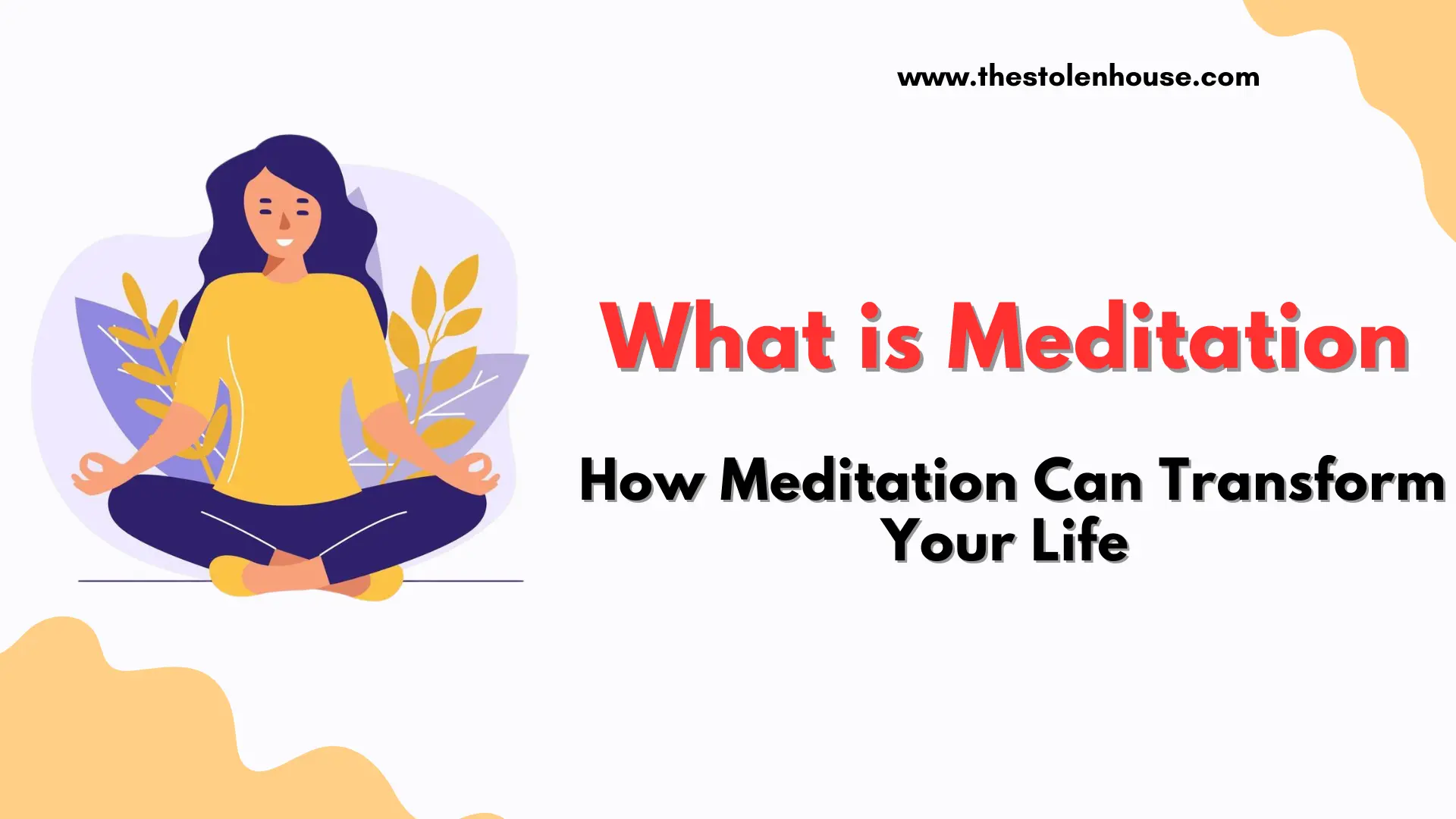Meditation is a discipline that involves concentrating or clearing the mind through a combination of mental and physical techniques.
People can meditate to relax, reduce stress and anxiety, and reap a variety of other benefits, depending on the type of meditation What is meditation? they choose. They even use contemplation to improve their general well-being, for example, involving it as an instrument to explore the difficulties of stopping tobacco items.
Guided meditations in full detail
This practice has existed for thousands of years and has evolved into a variety of forms all over the world. Notwithstanding, definite logical investigation of contemplation started exclusively over the most recent couple of many years. Electroencephalography and functional magnetic resonance imaging scans, among other diagnostic and imaging methods, have made a significant contribution to our understanding of meditation thanks to modern technology.
While noticing somebody pondering from the outside might recommend straightforward activities like breathing or tedious vocalizations, the inward experience is very significant. Modern diagnostic tools show that meditation can improve brain function and mental health.
Is it a basic meditation for beginners?
Meditation is an accessible practice that anyone can engage in, regardless of location or surrounding noise. It’s simple to learn and involves basic techniques. Like any new skill, the more we meditate, the more at ease we become with our minds.
The advantages of standard contemplation become recognizable moderately rapidly. According to research, just 10 days after using tools like Headspace, stress can be reduced. Various investigations have exhibited that care and reflection emphatically affect both mental and actual well-being. Whether the objective is to ease pressure, upgrade rest, increment center, or further develop connections, every reflection meeting carries us closer to laying out better propensities for a more joyful perspective.
We’ll set out on this excursion together. What is meditation By the time we get to the end of this article, we will know more about how to meditate and be ready to incorporate it into our daily lives.
What are the best meditation techniques?
As opposed to there being a solitary “best” contemplation strategy, the best one for you will rely upon your singular inclinations, objectives, and way of life. There are various sorts of reflection, each with its interesting methodology and advantages.
Listed below are some well-liked approaches that can assist you in finding your niche –
Quieting versus Knowledge Reflection –
- Quieting reflection: aims to improve concentration and cultivate a peaceful mental state. It includes zeroing in on a specific article, similar to your breath, a mantra, or actual sensations, and delicately returning your consideration at whatever point your brain meanders.
- Breath mindfulness contemplation: Zeroing in on the impression of your breath as you breathe in and breathe out.
- Mantra contemplation: Quietly rehashing a picked word or expression.
- Moderate muscle unwinding: Straining and loosening up various muscle bunches in your body.
- Directed contemplation: Tracking with a directed sound recording that leads you through the reflection interaction.
- Knowledge reflection: Intends to develop mindfulness and comprehension of the idea of the real world. It includes noticing your contemplations and feelings without judgment and letting them go. Care contemplation: Focusing on the current second without becoming involved with considerations or decisions. Strolling contemplation: Zeroing in on the impressions of your body as you walk gradually and purposely.
- Adoring thoughtfulness reflection: Developing sensations of thoughtfulness and empathy for you and others.
Time responsibility: How long might you at any point reasonably devote to reflection every day? A few procedures require a few moments, while others might take more time.
- Location: Do you want a peaceful space to contemplate, or are you happy with reflecting openly?
- Guidance: Do you like to learn all alone or with What is meditation with the assistance of an instructor or directed application?
A basic meditation to help you become more mindful meditation
This straightforward breath awareness meditation can assist you in becoming more mindful and present in the now. Even if you’re new to meditation, it’s a great way to start.
Track down an agreeable position
- Sit in a seat with your feet level on the floor and your back straight yet not firm.
- You can likewise sit on a pad on the floor, legs crossed serenely.
- Shut your eyes or relax your look descending.
Take note of your breath
- Feel your breath entering and leaving your nose or your stomach rising and falling with each breathe in and breathe out.
- Instead of trying to control your breath, just let it flow naturally.
- If your mind wanders, gently and without judging, bring it back to your breath.
Keep your focus on the here and now
- Focus on the actual vibes of your breath. Is it cool or warm? Is it shallow or profound?
- Notice any sounds you hear around you without becoming involved with them.
- Feel your body sitting in the seat or on the pad.
Go on for 5-10 minutes
- Begin with a more limited term and bit by bit increment as you settle in.
- This meditation can be done in any way you want. Simply be thoughtful to yourself and continue to take your consideration back to your breath at whatever point you find your psyche meandering.
Getting Started with Mindfulness Meditation
It’s a wonderful journey to cultivating peace, awareness, and presence in your life to start practicing mindfulness meditation.
Here is a basic manual to assist you with starting
- Reserve Time: Find a calm and agreeable space where you can sit or rest without interruptions. Start with just a few minutes a day and increase it gradually as you get more used to it.
- Posture: Sit or rest in an agreeable position. You can sit leg over leg on a pad or seat, or rest on your back with your arms by your sides. Finding a posture that allows you to be both alert and relaxed is essential.
- Centre around the Breath: Shut your eyes tenderly and carry your consideration regarding your breath. Notice the impression of the breath as it enters and leaves your body. You can zero in on the ascent and fall of your chest or the vibe of air going through your nose.
- Be Available: As you center around your breath, contemplations will inevitably emerge. When this occurs, simply and without judging, acknowledge the thought and gently return your focus to your breath.
20 Practical Tips for Understanding the Mind
Understanding the brain is a complicated and progressing process, however, the following are 20 viable tips to help you on your excursion:
- Notice Your Considerations: Focus on the contemplations that emerge to you over the day without judgment.
- Practice Care: Participate in care reflection to turn out to be more mindful of your viewpoints, feelings, and sensations.
- Look for Patterns: Search for repeating designs in your viewpoints and ways of behaving to acquire an understanding of your psyche’s activities.
- Journaling: Write down your thoughts, feelings, and experiences in a journal to help you see patterns and get clear.
- Practice Self-Empathy: Be thoughtful to yourself and practice self-empathy while confronting difficulties or troublesome feelings.
- Take Note from Others: Search out lessons and experiences from analysts, savants, and profound pioneers to extend how you might interpret the psyche.
- Examine psychology: Learn about various mental models and theories by taking psychology courses or reading books on the subject.
- Embrace Curiousness: Move toward your internal encounters with interest and receptiveness, looking to comprehend them instead of judging them.
- Consider Feelings: Carve out the opportunity to think about your feelings and their hidden causes, permitting you to answer all the more handily to them.
- Practice Appreciation: Develop a demeanor of appreciation to move your concentration from negative considerations to positive ones.
- Investigate Brain-Body Association: Find out about the association between the psyche and body through rehearsals like yoga, judo, or qigong.
- Look for Treatment: Think about treatment or advice to figure out more profound problems and gain knowledge of your oblivious psyche.
- Acknowledgment Preparing: Recognize your contemplations and sentiments as they are, instead of endeavoring to smother or avoid them.
- Participate in Creative Activities: Put yourself out there through creative activities like arrangement, painting, or music to exploit your mind.
- Challenge Convictions: To find fundamental predispositions and impediments in your reasoning, question your suppositions and convictions.
- Partner with Nature: Concentrate on nature to quiet the mind and gain perspective on your inner experiences.
- Eat carefully: Center around the material experience of eating to foster consideration and care.
- Limit Screen Time: Decrease receptiveness to screens and high-level contraptions to give your mind space to rest and recharge.
- Practice Vindication: To dispose of pessimistic sentiments, pardon yourself as well as other people for previous mishaps or complaints.
- Show restriction: Grasp that understanding the mind is a well-established adventure, and show limitations toward yourself as you investigate its complexities.
You can expand how you can decipher the mind and foster more noticeable internal amiability and knowledge.
Conclusion
There lies a colossal scene fit to be examined. It’s an What is meditation how Meditation Can Transform Your Life outing of self-disclosure, where each thought, feeling, and sensation holds a crucial viewpoint for understanding. Through care and reflection, we investigate this domain, loosening up the privileged insights of our most profound selves. We gain shrewdness and empathy with each step, developing a deeper connection to the world within and around us. We should consequently embrace this excursion with an open

